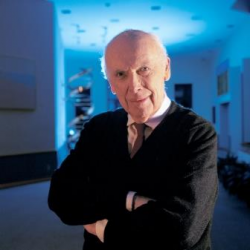James Watson

- Born
- 6 April 1928
In his early life, James Watson was a keen bird watcher and received a scholarship for tuition. He graduated from the University of Chicago at the age of 19 with a B.Sc. in Zoology.
Watson continued his interested in zoology in Indiana university, achieving his Ph.D. in 1950. During his doctoral years he was influenced by geneticists at Indiana and Schrodinger's book What Is Life? to start research in this area.
After a year of working on bacterial viruses, he attended a Symposium where he saw the first images of the X-ray diffraction pattern DNA makes. This sparked his interest and, after moving to the University of Cambridge, work on the structure of DNA began in earnest with fellow Cambridge scientist Francis Crick.
Using the experimental evidence, from Maurice Wilkins and Rosalind Franklin, of diffraction patterns and using models of DNA components as building blocks, they successfully discovered the double-helix structure in 1953. Watson and Crick’s paper was published in a British Journal, Nature, and the first time Watson explained the findings was in the Cold Spring Harbour Symposium, 1953, where many had not yet heard of the development.
Watson mentions in DNA: The secret of life that one scientist by the name of Seymour Benzer ‘realised that he could…map mutations – determine their order – along a gene…’ by using the newly discovered structure.
This breakthrough opened the door to understanding that DNA is the hereditary molecule in cells instead of proteins, as previously thought. Watson, Crick and Wilkins were awarded the Nobel Prize in Physiology or Medicine in 1962 for their work.
Science has always been my preoccupation and when you think a breakthrough is possible, it is terribly exciting.
Watson continued his research in molecular biology with the diffraction patterns of RNA in the California Institute of Technology and then, also in Harvard where the focus was on RNAs’ part in protein synthesis. While Harvard he taught students alongside researching for 15 years. He went on to become head of the Human Genome Project until 1992, securing funding, establishing the projects goals and even being the second person to have his genome sequenced.
Since then, Watson has written many books on molecular biology, received many honoured in the field and most recently, he was back in the media in December 2014 for putting his Nobel Prize up for auction to raise funds for research. It sold for £3 million but was gifted back to him from the buyer. This shows Watson is still and will continue to be a prominent figure in the scientific community for many years to come.
This profile was written by a Biology: Changing the World volunteer.



